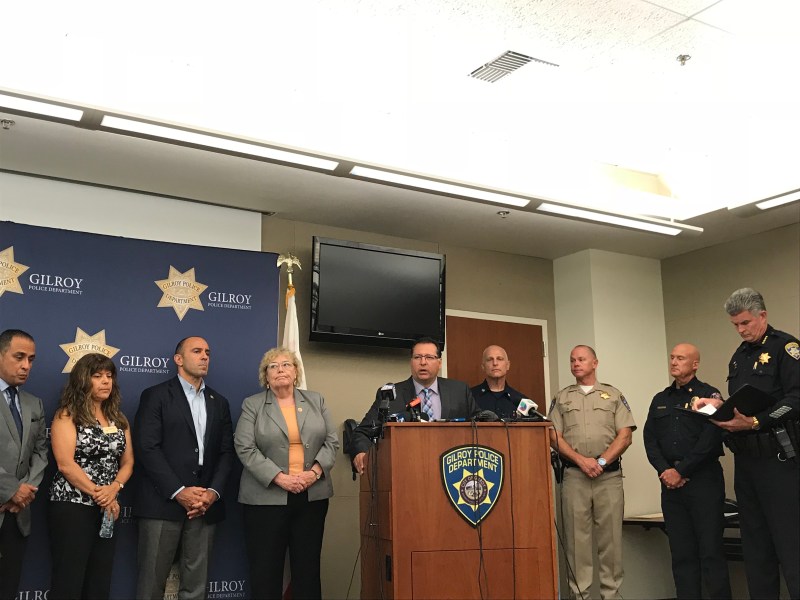A premeditated mass shooting at the annual garlic festival in Gilroy, CA left at least three dead and twelve wounded on Sunday. The tragedy triggered an unprecedented emergency response from Santa Clara County law enforcement and medical services, with several gunshot victims reportedly helicoptered 45 miles north to receive emergency care at Stanford Hospital.
The attack, executed with a military-style rifle purchased in Nevada, took place late on the last day of the 41st annual Gilroy Garlic Festival, a cherished Bay Area celebration of Gilroy’s status as the “Garlic Capital of the World.“
Before Sunday’s shooting, the festival was best known for its garlic ice cream. The garlic festival, which donates all its proceeds to Gilroy nonprofits, has become inseparable from the identity of the rapidly growing agricultural town located between San Jose and Santa Cruz.
2019 Garlic Festival President Shawn Keck talked to 4000 local volunteers after the shooting.
“We are heartbroken that senseless violence brought this year’s festival to such a terrible and tragic end,” Keck wrote in a statement released by the Festival. “We are truly grateful to the Gilroy Police Department, who responded immediately to prevent further loss of life, and to the hundreds of other first responders from regional and federal agencies who have provided additional support.”
Gilroy police officers stationed in the middle of the festival grounds engaged and neutralized the shooter within a minute of the first gunshots at 5:41 p.m., said Gilroy Police Chief Scot Smithee in a speech to the press late Sunday night. First responders rushed to the scene by the hundreds to gather festival attendees and launch a massive manhunt for a probable second suspect.
Medical authorities also rushed to treat the wounded and dying, several of them children. During the short attack, the shooter fired indiscriminately into crowds, at vendor tents and at a bouncy house area where six-year old victim Stephen Romero was reportedly playing with his mother and grandmother. Thirteen-year-old San Jose native Keyla Salazar and 25-year-old Trevor Irby — a recent college graduate from Romulus, NY — were also killed in the shooting.
Alberto Romero, the father of Stephen Romero, had stayed home from the festival to study for the electrician’s exam. He was interviewed by journalists outside Santa Clara Valley Medical Center where his mother-in-law and comatose wife were being treated late in the night. He described driving to St. Louise Hospital in Gilroy to see his son, who had been shot in the back, after his wife called him from the festival to say, “They shot him.”
“They said they were working on him, and five minutes later they told me he was dead,” Alberto said.
CBS news reported that medical responders sent gunshot victims to hospitals across the South Bay via ambulance and helicopter. Six gunshot wound patients were taken to St. Louise Medical Center, five to Santa Clara Valley Medical Center, one to San Jose Regional Hospital and two to Stanford Hospital.
In a phone call with The Daily on Monday, Stanford Hospital spokesperson Lisa Kim confirmed that the two patients at Stanford Hospital were still being treated.
Ten more patients went to St. Louise Medical Center for minor, non-gun-related wounds, such as trampling injuries.
Ruby Mo, an executive assistant with the Stanford Office for Religious Life, told The Daily that the Office has not yet planned a Gilroy memorial. The Office has coordinated vigils after previous mass shootings, though, and an announcement could be on the horizon.
“Gilroy is such a small, harmless, loving community and I’m incredibly angry that a place like that should be attacked,” wrote Gilroy resident Pranavi Kethanaboyina ’22 in a statement to The Daily. “The garlic festival is a beloved tradition for so many people. I spent so many summers volunteering there, and I’m hurt that someone should turn it into the scene of the latest national tragedy.”
Kethanaboyina expressed a desire for community healing and stronger gun control going forward.
“It’s a little cliche [to say] you never imagine something like this happening in your own community, but it’s true,” she wrote. “And it becomes an even harsher truth as you see people you know and love suffering and affected by what is so preventable, what has been plaguing our country for way too long.”
Contact Cooper Veit at cveit ‘at’ stanford.edu.
